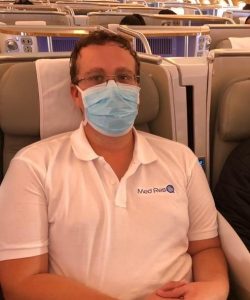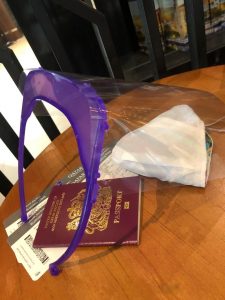Despite having spent much of my working life as a flight nurse either at an airport or on a plane, like many, I was quite anxious about flying in a post COVID world. After weeks on the ground, the opportunity finally came. A Filipino patient stranded in the UK needed assistance to return home to Manila, after careful planning we (Med ResQ) obtained the official support and seal of approval from the Consul General at the Philippines Embassy and we were set to go! Our patient got home safely and I thought I would take the opportunity to share my observations of what it is like flying during a pandemic!
The first major change you will notice at the airport is perhaps the change of terminals. Heathrow has closed two of its terminals and condensed flights into terminal two and five. Gatwick has closed the South terminal; all flights are now operating from the North terminal only. Similar changes can be seen in many airports around the world. Therefore it’s always a good idea to re-check with the airport website or carrier which terminal the flight will be operating out of. Airlines that were traditionally always based in one terminal may have temporarily moved.
As you enter the terminal, you will notice that many signs are reminding you to keep your distance, wear a mask, and wash your hands frequently. We have all become used to seeing these as we return to work or go shopping, the airport is no different, these have become part of our normal daily routines. The only difference to that of a supermarket is many airports are taking your temperature as you enter. This is performed by a thermal camera, so you most likely won’t even notice this is being performed. Masks and alcohol gel are provided for free at all entrances. Check-in and security are the same as before. You can check-in by app, self-service machine, or the traditional check-in desk. You are expected to maintain social distancing whilst waiting your turn, markers are on the floor, otherwise, this remains the same.
During May and June, many airport facilities were closed. However, we are seeing a steady return of the shops, cafes, restaurants, and lounges at the airport. The seating areas have seats blocked, similar to that on buses to allow for social distancing, and spacing lines are installed on the floors in shops, cafes, and restaurants. Airline lounges are starting to open but self-serve drinks and buffet food is no longer permitted. Lounges are providing limited delivery to table service or self-serve packaged refreshments.
Onboard the flight is perhaps where most of the changes have occurred. Each airline has developed its own policies, whilst for most, there is little change, other than now being asked to wear a mask on board. Some airlines have made additional changes. Several airlines, including British Airways, have reduced its onboard refreshment service. Qatar airlines require all passengers to wear a visor (provided by the airline) and mask onboard. Emirates and Qatar also require all passengers to have a Negative COVID test result within the last 96 hours. Always check with your airline if there are any special airline specific requirements.
An international report published in “The Lancet” analyzed data from 172 studies internationally. It concluded that by wearing a mask, there is just a 3% chance of catching COVID even when in close proximity to someone with COVID-19. The risks are further reduced if the individual with COVID is also wearing a mask. Aircraft are also fitted with high-efficiency particulate air filters (HEPA) which securely retain COVID Virus droplets and aerosol with COVID containing particles or nuclei. So the risk of transfer during flight is relatively low with these precautions in place. However, I could still detect a sense of nervousness amongst the cabin staff who were still getting used to the new measures in place. An innocent cough amongst passengers would occasionally draw concerned looks from staff and other nervous passengers.
For most passengers, the changes at the airport or indeed onboard are no different from those that we have become familiar with whilst going to the supermarket or taking public transport. As more people decide to travel by air for work or holidays, no doubt these precautions will begin to normalize and become an accepted part of travel. One thing is for sure, this ‘new normal’ will be here for some time yet.
Christopher Berry – Flight Nurse / Medical Case Manager





